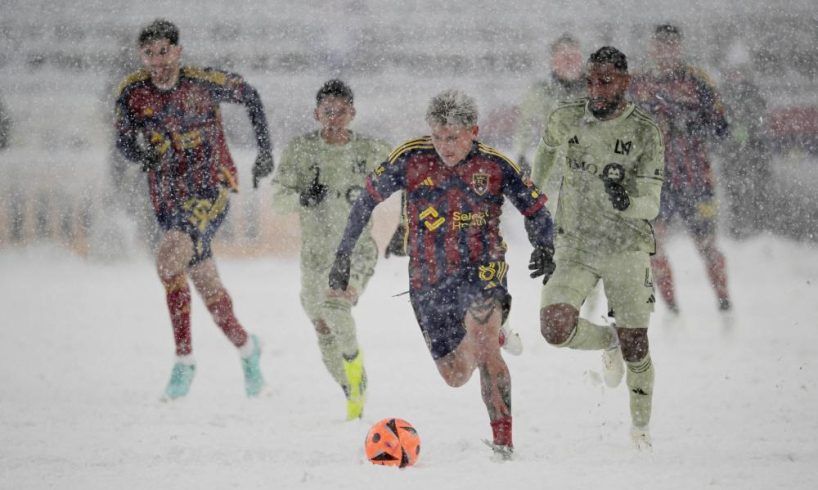
LAFC lost 3-0 to Real Salt Lake in blizzard-like conditions in Utah. Photograph: Kelvin Kuo/USA Today Sports
If former Tottenham goalkeeper Hugo Lloris had hoped to segue into a sunny semi-retirement after his move to Los Angeles, his debut for LAFC would have felt especially satisfying. The 36-year-old World Cup winner made a club-record seven saves in a victory over the Seattle Sounders beneath the California sun on the opening weekend of the 2024 MLS season.
A week later, however, in his first away match since moving to the US, Lloris experienced a less comfortable time. With his goalkeeper’s gloves acting more as a barrier against frostbite than a shot-stopping aid, he was forced to pluck a fluorescent orange match ball from his net three times in the first half after a sudden snowstorm and near-freezing temperatures descended upon Real Salt Lake’s America First Field.
Several players sported snoods. Eduard Atuesta, LAFC’s Colombian midfielder, wore his pulled up to just beneath his eyes. Kick-off had already been delayed two hours due to high winds. And once the match did finally begin, referee Aleksandar Zhelyazkov ordered the players off the pitch after just four minutes when lightning streaked across the sky above the stadium. A mandatory 30-minute postponement was enacted.
Related: Genial Luis Suárez shows why he’s Inter Miami’s true path to MLS glory
Within five minutes of the teams returning to the field, a blanket of snow covered the grass. Any time play was concentrated on one side of the field, the grounds staff shuttled on, shovels in hand, at the other end in an effort to preserve the visibility of the pitch markings. Zhelyazkov was forced to carve lines into the snow to indicate how far back defenders should stand on free-kicks. By full-time, four inches of snow had fallen.
Due to the sheer expanse of the US and its varying climates, it is a fact of MLS life that a team can play in blazing heat one weekend and subzero cold the next. Extreme winter conditions are already one of the key reasons why the league’s schedule does not line up with many of its European counterparts, instead running February to October to best capture the warmer months.
“We continue to have to manage the largest geographic region for any league in the world, and the most weather changes and time changes of any league in the world,” commissioner Don Garber told ESPN in 2021 when asked why the MLS season is not scheduled to coincide with the major European leagues. “As such, the likelihood of us playing in a dramatically different calendar is far, far, far in the future and we would only do it if we saw the value for our fans and for our competition. Today, we don’t see that value.”
After Real Salt Lake’s blizzard-blitzed 3-0 victory over LAFC, there have been calls for more to be done to ward against teams being asked to play in such conditions in the future.
“My lower back is killing me,” LAFC defender Ryan Hollingshead said after the game when he was asked whether he planned to raise the playing conditions with the MLS Players’ Association. “It’s just like trying to run on an ice rink. You’re sliding and slipping the whole time. The whole goal is just to not fall over and hurt yourself. It will absolutely be taken to the players association. I know our rep will be having that conversation immediately.”
LAFC coach Steve Cherundolo wasn’t happy either. “It is laughable,” he said. “It just baffles me that we would put players through this. I didn’t even watch the game for the last 20 minutes. You couldn’t see anything.”
Few clear solutions have been posited – whether it’s a shrinking of the schedule to move the season’s start date further into spring, or simply a relaxing of the current attitudes so averse to game postponements – but player safety is a legitimate concern.
Related: Redondo signing shows Inter Miami are planning for life beyond Messi
For much of its existence, though, MLS has sought to fit in with the global soccer landscape in pursuit of credibility. A fear of US soccer being regarded as a punchline or considered some kind of footballing curio led, for instance, to the abandonment of the thoroughly entertaining hockey-style penalties the league utilised to settle tied games in its early years. Having long since established a firm and respected standing in the soccer landscape, MLS must look to stand out from the crowd as it aims to grow further. It should lean into its idiosyncrasies.
The variance in weather conditions across the US presents a unique challenge to players and clubs, unlike anything found in the elite European leagues. It creates real and distinctive home-field advantage against opponents not used to certain conditions. It adds an endurance element to the regular season, too, burnishing the feeling that playoff qualification has been earned. Being crowed champions – with a salary cap, weather challenges and a bloated playoff structure – means you’ve arrived on the other side of a gauntlet no other club in world football has faced.
There is also a nostalgia component fostered by the freezing temperatures and swirling snowstorms. In an age of hi-tech under-soil heating, hybrid synthetic playing surfaces and fully covered stadiums, the sight of an orange ball ploughing through driving snow belongs largely to a bygone era in Europe’s most monied competitions. MLS is still the new kid on the soccer block, relatively speaking, but it can provide a regular glimpse into a yearned-for past.
Snow games were not what attracted Lloris and his fellow big-name veterans to the US to play out the remainder of their careers – and player safety must, of course, take priority above the spectacle – but the variance and unpredictability of its weather will bring interest to MLS long after the imported stars have retired.






